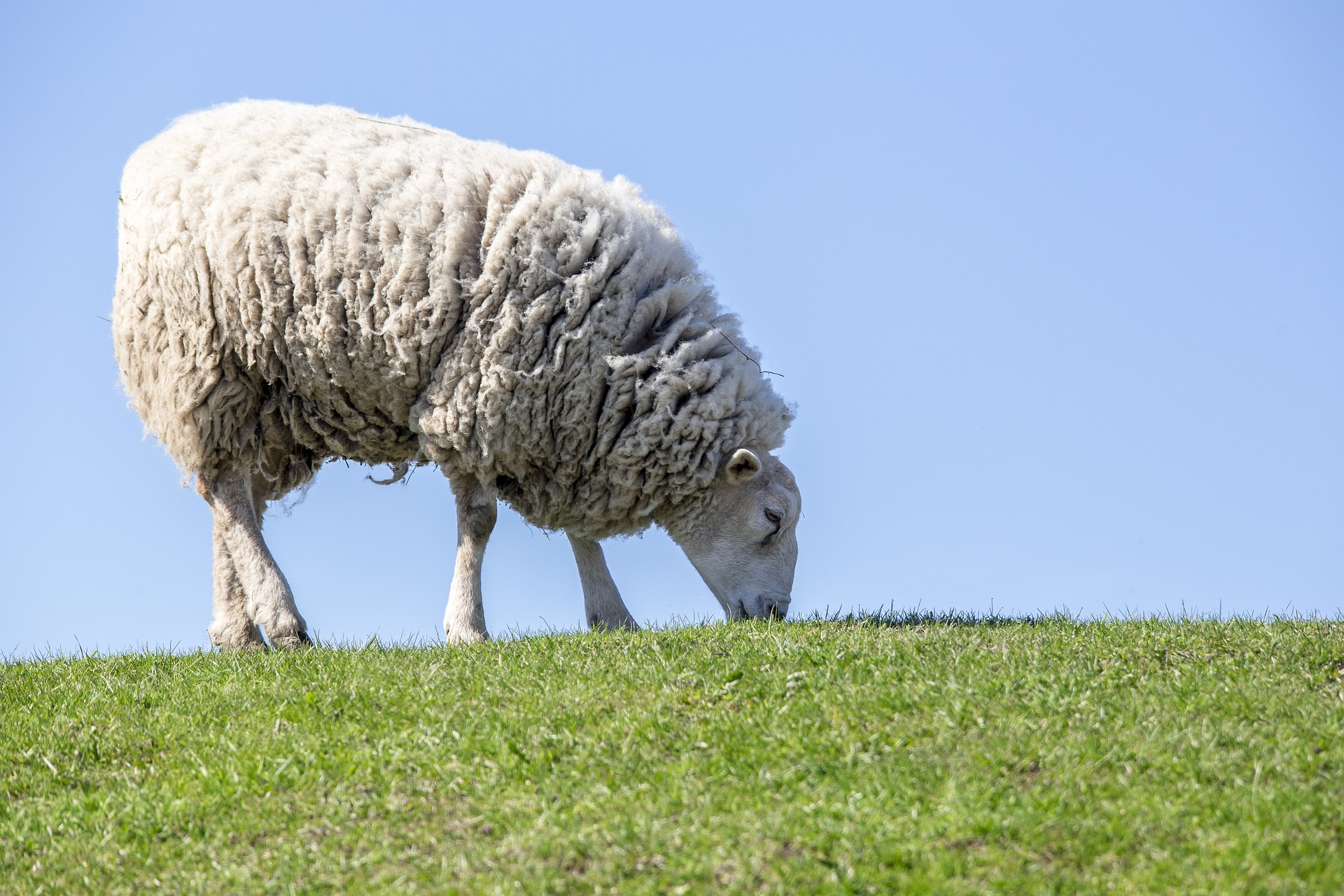Here’s a complete and detailed overview of the Sheep (Ovis aries), one of the world’s oldest and most important domesticated animals.
🐑 Sheep (Ovis aries)
Taxonomy
- Kingdom: Animalia
- Phylum: Chordata
- Class: Mammalia
- Order: Artiodactyla
- Family: Bovidae
- Genus: Ovis
- Species: O. aries
Scientific name: Ovis aries
Common name: Sheep
Identification
The Sheep (Ovis aries) is a medium-sized domesticated ruminant mammal, widely raised for its wool, meat (mutton and lamb), and milk.
- Size: Typically 45–160 cm in body length, height 60–130 cm at the shoulder.
- Weight: 45–160 kg (varies greatly by breed).
- Coat: Covered in wool, a dense, crimped fiber that grows continuously.
- Color: Usually white, though some breeds are black, brown, or spotted.
- Head: Narrow with a sloping profile; males (rams) often have large curved horns, while females (ewes) may have smaller horns or none at all.
- Eyes: Positioned laterally, giving a wide field of view; horizontal pupils aid in scanning the horizon.
Distribution and Range
Domesticated sheep are found worldwide, with populations on every inhabited continent.
Origin:
- Descended from the wild mouflon (Ovis orientalis) of the Middle East and Central Asia.
- Domestication occurred around 10,000 years ago in the Fertile Crescent.
Today, sheep are most abundant in:
- Europe
- Australia and New Zealand
- Asia (especially China, India, and Central Asia)
- Africa and South America
Habitat
Sheep are highly adaptable and can live in a variety of environments:
- Grasslands and meadows
- Mountain slopes and alpine regions
- Semi-arid plains and highlands
Domesticated sheep thrive in pastoral and agricultural landscapes, often in flocks managed by humans.
Behavior
- Social animals: Live in flocks for protection and cooperation.
- Communication: Use bleating sounds, body posture, and scent to communicate.
- Grazing: Feed primarily on grasses and low-growing vegetation; graze for many hours daily.
- Intelligence: Can recognize individual faces (human and sheep) for up to two years.
- Instincts: Strong flocking behavior helps them avoid predators.
Diet
Herbivorous grazers that feed mainly on:
- Grasses
- Clover
- Herbs
- Forbs and shrubs
They ruminate, meaning they regurgitate and re-chew partially digested food (cud), aiding digestion through microbial fermentation in the rumen.
Reproduction and Life Cycle
- Breeding season: Usually in autumn; seasonal breeders influenced by daylight.
- Gestation: ~150 days (5 months).
- Lambing: Most ewes give birth to 1–3 lambs in spring.
- Lifespan: 10–12 years on average; some breeds live up to 15 years.
Parental care:
Ewes nurse and protect their lambs closely for several months, relying on vocal and scent recognition.
Domestication and Uses
Sheep have been one of humanity’s most valuable domesticated animals for millennia.
Main products:
- 🧶 Wool: Used for textiles; the finest from breeds like Merino.
- 🍖 Meat: Lamb (young) and mutton (adult).
- 🥛 Milk: Used for cheese (e.g., Roquefort, Pecorino, Feta).
- 🐑 Land management: Used in ecological grazing to maintain grasslands and reduce wildfire risk.
Domestication has produced hundreds of breeds, adapted to different climates and purposes.
Notable Breeds
| Type | Example Breeds | Main Use |
|---|---|---|
| Wool breeds | Merino, Rambouillet | Fine wool |
| Meat breeds | Suffolk, Texel, Dorper | Meat |
| Milk breeds | East Friesian, Awassi | Dairy |
| Hardy mountain breeds | Scottish Blackface, Soay | Adapted to rugged terrain |
Predators and Threats
Natural predators (in wild or feral conditions):
- Wolves, foxes, coyotes, eagles, lynx
Domesticated sheep are generally protected by humans and herding dogs or guard animals (like donkeys or llamas).
Threats also include:
- Overgrazing
- Disease (such as foot rot, parasites)
- Habitat degradation in unmanaged grazing systems
Conservation Status
- Domesticated populations: Not threatened
- Wild relatives (e.g., mouflon, argali): Some are vulnerable or endangered due to hunting and habitat loss.
Sheep remain one of the world’s most numerous large domesticated animals, with more than one billion individuals globally.
Ecological Role
- Maintain grassland ecosystems through grazing.
- Help prevent shrub overgrowth.
- Recycle nutrients into soil via manure.
However, overgrazing can lead to soil erosion and loss of biodiversity if unmanaged.
Key Identification Points
| Feature | Description |
|---|---|
| Scientific Name | Ovis aries |
| Common Name | Sheep |
| Family | Bovidae |
| Body Length | 120–160 cm |
| Weight | 45–160 kg |
| Diet | Herbivorous grazer |
| Habitat | Grasslands, farmlands, hills |
| Domesticated Since | ~10,000 years ago |
| Uses | Wool, meat, milk |
| Conservation Status | Domesticated (Not Threatened) |
Interesting Facts
- Sheep have a field of vision over 300°, allowing them to spot predators from behind.
- Their pupils are rectangular, giving them excellent peripheral sight.
- A sheep’s fleece grows continuously and must be shorn annually to prevent overheating or health issues.
- Lambs can recognize their mother’s bleat within hours of birth.
- Sheep can show emotional responses and form social bonds within flocks.
Summary
The Sheep (Ovis aries) is a cornerstone of human civilization — a gentle, social grazer that has provided wool, meat, and milk for thousands of years. Adapted to a wide range of climates and terrains, sheep remain vital to agriculture and ecology alike. Their intelligence, flocking instinct, and close connection with humans make them one of the most enduring symbols of pastoral life.
Views: 1228
Subscribe to the newsletter:
